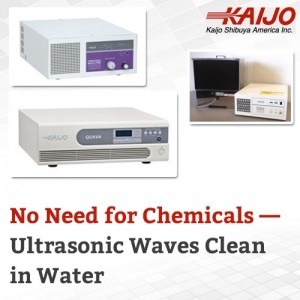No Need for Chemicals – Ultrasonic Waves Clean in Water
August 29, 2016
 Industrial cleaning of machine parts, tools and components has traditionally meant cleaning with strong chemicals, blasting with streams of water and mechanical scrubbing. These techniques all have their drawbacks with regard to effective cleaning and they harm the environment by using large amounts of water with chemical runoff. Ultrasonic waves clean faster, better and need only plain water. There is a compelling case to be made for replacing traditional cleaning methods with industrial ultrasonic cleaners.
Industrial cleaning of machine parts, tools and components has traditionally meant cleaning with strong chemicals, blasting with streams of water and mechanical scrubbing. These techniques all have their drawbacks with regard to effective cleaning and they harm the environment by using large amounts of water with chemical runoff. Ultrasonic waves clean faster, better and need only plain water. There is a compelling case to be made for replacing traditional cleaning methods with industrial ultrasonic cleaners.
How Ultrasonic Cleaning Works
Industrial ultrasonic cleaning systems use an ultrasonic generator to produce high frequency electric signals with a frequency range of about 20 kHz up to 200 kHz. These signals are fed to a transducer that is immersed in a water bath. The transducer vibrates to convert the electrical signal to sound waves in the water.
The sound waves produce tiny cavitation bubbles that continuously appear and collapse as each sound wave passes. As they collapse, the bubbles scrub the surface they are cleaning and remove contaminants and foreign material. The cleaning action is more intense with larger bubbles at low frequencies and gentler with smaller bubbles at higher frequencies. The cleaning effect is quick, thorough and mechanical, using no solvents or other chemicals.
Advantages
For managers at manufacturing facilities faced with the high cost of cleaning chemicals and the costs of complying with environmental regulations, ultrasonic cleaners represent an attractive alternative to traditional cleaning methods. But even beyond the question of cost savings is the fact that ultrasonic waves clean more effectively than chemicals and solvents.
The three additional advantages of ultrasonic cleaning are that these systems clean small holes and crevices, cleaning takes less time and they don’t damage the parts being cleaned. Ultrasonic waves bend around corners and the cleaning water enters small holes and cracks that chemicals can only diffuse into slowly and mechanical brushes can’t penetrate. The intense mechanical bubble cleaning action works more quickly than waiting for chemicals to dissolve or soften grime. While the bubbles are quick and intense, once the correct frequency is applied they don’t damage the underlying material to be cleaned as scrubbing, corrosive chemicals or water blasting might do.
Kaijo’s Ultrasonic Technology
Kaijo Corporation has been a global leader in ultrasonic technology since 1948 and developed its first ultrasonic cleaner in 1957. Since then, the company has continuously improved the effectiveness of the cleaning technology, added to their product line of industrial ultrasonic cleaners and reduced the costs of the ultrasonic cleaning equipment. Today Kaijo’s ultrasonic cleaning systems offer state-of-the-art technology with excellent cleaning performance at a price that is highly competitive with that of traditional cleaning systems.
Kaijo’s Industrial Ultrasonic Cleaners
Kaijo’s product line includes the Phenix III Turn Key Ultrasonic Cleaning System for general industrial use and specialized systems such as the Quava Mini table top ultrasonic system for smaller more delicate parts. Individual components include ultrasonic generators for a wide range of frequencies, transducers for producing the sound waves in water and tanks for the cleaning water and the parts to be cleaned.
Customers who want to change from traditional cleaning methods can purchase the latest technology in a turnkey ultrasonic cleaning system or buy an ultrasonic generator and transducers to use with existing tanks. Kaijo’s experienced support team can help customers with their choices and ensure that they get the best system suited for their particular applications. Call Kaijo at 408 675-5575 or email info@kaijo-shibuya.com for a free consultation or quote on using ultrasonic technology for your application.





